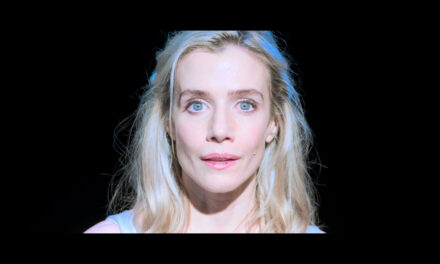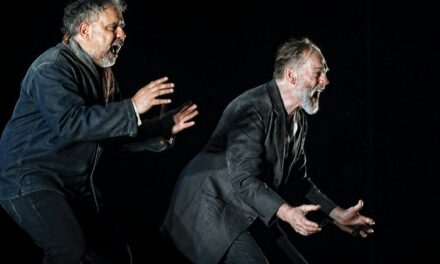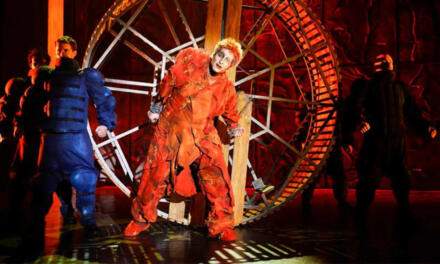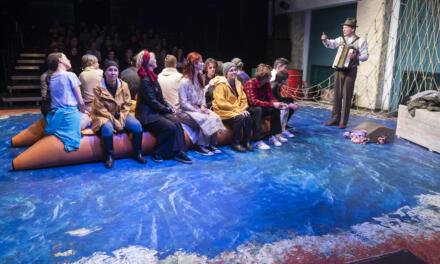Waiting for Lucky and Quê Onde [1] were presented on the evening of Friday May 19, 2023 in Teatr BOTO (Boto Theatre), Sopot, as part of the Between.Pomiędzy Dispersed Festival 2023. This was in line with previous editions of the festival where non-canonical performances of Samuel Beckett texts had been staged or shown on film. Such occurrences included staged versions of Krapp’s Last Tape and Company (2018) and films of Happy Days (with the well-known Polish actress Maja Komorowska) (2010), Rockaby, Rough for Theatre I and Breath (2021). Meanwhile, as part of this year’s festival, Stanley E. Gontarski discussed and then shared visual documentation of the making of his 2018 Between.Pomiędzy festival staging of Ohio Impromptu and his films based upon Beckett texts …but the clouds… (2018) and Beckett on the Baltic (2019) [2]. Meanwhile, on the same programme as the Brazilian double-bill, there was a conversation with Wang Chong, a theatre-maker from China who, in 2021, had presented his online version of Waiting for Godot in Wuhan during the COVID-19 lockdown. By the second part of the programme on Friday evening then, at which time Waiting for Lucky and Quê Onde were scheduled, the audience at the Boto Theatre had been primed for audacious interpretations of Beckett text – and what they experienced certainly lived up to expectations.
Waiting for Lucky is based upon the character Lucky from Samuel Beckett’s Waiting for Godot and centres around his actions in the play as well as his one speech, approximately three quarters of the way through the first act – a tirade of pent-up emotion and, on the face of it, nonsense, against his position (condition) as slave to Pozzo but also against the world in general. This performance concentrates on only one small part of Waiting for Godot and thus provides an opportunity for an extreme close-up of Lucky and the issues that he carries with him. Additionally, because Waiting for Lucky was performed in Portuguese in front of an international audience, the reception of the drama relied on the vocal and physical skills of the actor, Ronei Vieira, more so than the text as the primary means of conveying meaning – although as the audience was partly comprised of Beckett scholars, it is fair to assume that in their imaginations many people ‘heard’ their own language versions of the soliloquy as it was being delivered.
Waiting for Lucky starts powerfully and for some people in the audience, as I was watching it, with a shock. The Boto Theatre space is small, a black box on a first floor with a stage approximately 6 by 8 metres in size. To get to their seats, the audience enters by walking up a flight of stairs and across the right-hand side of the stage, while actors must enter using the same route or stage-right / left from two small rooms adjoining the performance area. In Waiting for Lucky the stage was bare, apart from an unfurled screen for projection on the back wall and a wheelchair, stage-left, that contained what appeared to be a mannequin weighed down with two bags pressing on its chest and lap. The start of the performance was not announced but occurred suddenly when the mannequin came to life and wheeled itself to the centre of the space upstage. This caused some people around me to gasp as it was unexpected – the mannequin come-to-life. At the same time, a video projection on the screen behind showed a Brazilian tribal ceremony: large figures adorned in red, white and black body decorations, and painted in similar colours, stepped rhythmically to drumbeats and chants. In front of this, meanwhile, Lucky slowly lifted the two bags that had previously weighed on his body when he was an inanimate mannequin. This slow lifting, first one bag in the left hand then the other bag in the right, was repeated a number of times, as if Lucky was trying to balance the two – attempting to find equilibrium. Then the bags were dropped and he began his monologue:
LUCKY (exposição monótona) Dada a existência tal como se depreende dos recentes trabalhos públicos de Poinçon e Wattmann de um Deus pessoal quaquaquaqua de barba branca quaqua fora do tempo e do espaço que do alto de sua divina apatia sua divina athambia sua divina afasia nos ama a todos com algumas poucas exceções não se sabe por quê mas o tempo dirá […] [3]
[LUCKY: Given the existence as uttered forth in the works of Puncher and Wattmann of a personal God quaquaquaqua with white beard quaquaquaqua outside time without extension who from the heights of divine apathia divine athambia divine aphasia loves us dearly with some exceptions for reasons unknown but time will tell[…].] [4]
Vieira’s Lucky, wheelchair bound, is acted from the waist up. All of the strength of the words is given in the energy that the actor invests in his torso, his arms, his hands and his head. These are in constant movement as he rants, placates and pleads to the audience, a seemingly unstoppable volcano of energy. Then just as quickly and astonishingly as the performance began, it stops. The eruption has gone out and Lucky collapses, slumps in on himself: Waiting for Lucky is over. Because of the supreme energy and control that the actor gives to the part, where every twist of the body, outstretched arm, crook of a finger or lift, turn and dip of the head means something, this individual and heartfelt plea brims with the pent up emotion, anguish and anger that we know from the Lucky in Waiting for Godot. And, just as with that Lucky, we feel terrific empathy for the character, although, on first reasoning, we may not know exactly why. I would also suggest that this Lucky demands even more of our sympathy and outrage, because in this performance it is his undistilled version of events, his own personal waiting and the abuses he suffers, that we bear intimate witness to.

Ronei Vieira, Waiting for Lucky. Between.Pomiędzy Dispersed Festival 2023. Photograph: Robson Corrêa de Camargo.
There would seem to be other issues alluded to, however, over and above Lucky’s personal experience of injustice. The juxtaposition of Beckett’s Lucky monologue with a tribal ceremony, the Kuarup, perfomed by the indigenous peoples of the Xingu region in Brazil [5] – the powerful portrayal of the former in the flesh and the mesmerising presence of the latter on screen – suggest something deeper, something rooted in Brazilian experience. In this sense, the universal and abstract of Beckett serves the here-and-now of particular predicaments: the need to ensure the flourishing of indigenous people’s ways of life in spite of attacks on them by logging and mining companies greedy for profit; the imperative for embracing a process of anthropophagy – cannibalism which involves one culture taking from another to invigorate itself without surrendering to the second culture – so that, in this case, western influences are meaningfully synthesized rather than being a forced, inappropriate and, therefore, ultimately ineffective import. Waiting for Lucky, acted by Vieira and directed by Robson Corrêa de Camargo achieves both of these feats. It also, and importantly, reconfigures what Beckett might be rather than what it is allowed to be in terms of the recognized canon. This Lucky shows the possibility of maintaining the integrity of the Beckettian character but fitting him for new purpose.
I had seen Máskara’s [6] Quê Onde earlier, on their home ground in Goiânia, Brazil. The performance then was powerful. The filmed version only served to support the strength of the live performance and also revealed elements that were not so apparent from the staged version. The power of this interpretation, again directed by Robson Corrêa de Camargo and starring Ronei Vieira, as well as Edlúcia Barros, Dorivânia Xavier, Ilmara Damasceno and Allan Lourenço, is undoubtedly the physicality and use of voice by the actors working in full harmony with their version of the Beckett text. Additionally, through the skill of the director and the actors, as well the particularities of the interpretation, this performance takes the playwright’s original text much further. Beckett’s What Where, which usually has a performance time of 10 minutes, in the hands of the Máskara team performing Quê Onde, has a duration of approximately 50 minutes. In both the live performance and the filmed version, the actors add movements that are not in the Beckett script. They shuffle into their positions on stage. Their actions are slow and full of pain: pained in the way the actors enact them, painful to watch.
Bam, as a perhaps leader, stands tall: head thrust upwards, hands and arms pressed downwards, so that the figure appears to have pushed himself up into a superior position. And, indeed, as with the Beckett text, Bam is the dominant presence in the film, while V (voice of Bam), supplied by Allan Lourenço, adds a sonorous – onerous – quality in keeping with the threat that Bam poses. This is made even more noticeable by Vieira’s portrayal. As I mentioned earlier, Vieira is a consummate Beckettian actor, he endows the characters he inhabits – brings them to life – with qualities of abstraction but also a tangible physicality (even on film) that is as appropriate for Lucky as it is for Bam. Vieira’s Bam stands firm and thus dominates not only with his words but also his stature. The hooded Bom, as one who is tortured, enters and exits the stage reluctantly. Played by Edlúcia Barros, Bom cowers and moves in a contorted way, extending out and withdrawing her arms in stiff gyrations, flexing and unflexing her fingers in arthritic knots that suggest this meeting is as traumatic for her as the torture she has experienced offstage – the nature of which is implied in Beckett’s text. Barros’ masterful portrayal captures the full horror of her pain and physical suffering as well as the numbing doubt felt by the tortured. Meanwhile, Dorivânia Xavier’s Bim and Ilmara Damasceno’s Bem display the haughtiness of those who are involved in the process of inflicting torture. They enter stiffly, with similar contortions of arms and hands as Bom, but whereas Bom is hooded and keeps a low posture, Bim and Bem stand proud to report to Bam and to receive new orders. The actors also endow each of their characters with an individuality that goes beyond Beckett’s abstraction. Xavier’s Bim appears flush with the joy of one who is recently released and who will now take on the mantle of torturer, while Damasceno’s Bem, through force of will, fights to maintain dignity as she receives her orders to take the now quivering and hooded figure of Bim away for torture. There are then, hints of the different personalities of the characters hidden behind the sameness of the repeated dialogue, conveyed through the remarkable skills of the actors in terms of voice modulation and command of movement.

Maskara’s Quê Onde. Image taken from the film Quê Onde cinematography Erik Ely and Hudson Cândido.
The costumes and staging support what the actors do on stage and in the film but also add nuances that, in addition to the Portuguese language, make this a particularly Brazilian version of Beckett’s What Where. The costumes take the form of long singlets, cylinders of heavy material whose circular hems skirt the floor, so that the bodies of the actors are hidden apart from their arms and heads. This, of course, allows the arms and hands, a major part of the expressive means employed by the actors on the stage and in the film, to be fully visible. The elongated singlets also have hoods, which Bom and then Bim, as the accused, make use of, to ensure that in their encounters with Bam their faces are not visible. The colour of the garments are also important: they are the yellow ochres and red sienna’s of the Brazilian earth. Indeed, in the film, the connection with Brazil through its natural world is even more pronounced. For the live performance I saw in Goiânia, the play was staged in a theatre workshop space whose floor was a dull grey concrete. In the film, the enactment is done in a space with a highly polished wooden floor. Visually, this means the characters are extended into the ground through the reflections of the lower parts of their costumes, as if they have become the vast trees that make up the rainforest: the reflections of the costumes into the depths of the floor suggest roots extending endlessly into the soil. The actors’ slow movements, the gnarled configurations of arms and hands support this impression. I would also suggest that Máskara’s enactment of Quê Onde and the way that it is staged, both in the live performance and the film, suggest another Brazilian context, one which shows the relevance of the Beckett text to Brazil and also the contemporary world in terms of its social and political significance.
The underlying theme of torture which pervades the Beckett text of What Where and which is so skilfully shown in the Máskara staged and filmed versions of Quê Onde, also has echoes in Brazilian history. The most resonant, perhaps, is the period of the military dictatorship from 1964 to 1985. However, there are other events connected to forms of oppression practised in Brazil and other countries, and these are hinted at in a montage of film clips given at the end of the Quê Onde. For example, following on from images of the majestic amazon and its rainforest, there are references to brutal murders committed within the last decade involving Brazilian teenagers, a member of the LGBT community and a person of colour. There are also images of other people who have been murdered: a Brazilian journalist during the time of the dictatorship, and a British reporter and an indigenist and Brazilian preservationist, both killed in 2022 by people involved in illegal fishing [7]. Additionally, in what appears to be an acknowledgement of present-day events in Ukraine, the montage begins with the famous sequence from Eisenstein’s Battleship Potemkin, where troops loyal to Tsarist Russia descend the notorious Primorsky Stairs in Odessa and shoot down innocent civilians [8].
This year’s Between.Pomiędzy Festival has a new dispersed format in which its usual focus on literature, theatre and scholarly reflection is given in events that cover the whole of the calendar year as well as its more traditional slot of the third week in May. The Brazilian Beckett double-bill of Waiting for Lucky and Quê Onde took place in that third week of May and, to my mind, was one of the highlights of the scheduled events at that time. Ronei Vieira’s Waiting for Lucky presents a powerful exposition of emotions felt by the oppressed which may not always find their expression in rational utterance. Meanwhile, Maskara’s Quê Onde is a truly remarkable version of Beckett’s What Where, one which through its extended timeframe and the ‘excruciating’ performance of actions, connects its audience in a very real way to the physical and mental suffering of those caught up in cycles of oppression and torture. In fact, with Vieira’s Waiting for Lucky and Máskara’s Quê Onde, Beckett text was brought alive in ways that I have not experienced in other stagings. This, it seems to me, is due to the willingness for experimentation and skill of the Máskara actors and the creative ingenuity of their director Robson Corrêa de Camargo. Indeed, with regard to Quê Onde, I suspect Beckett as a director would have been proud to stage such a production of What Where!
Acknowledgement: I would like to thank Robson Corrêa de Camargo and Ronei Vieira for their invaluable consultations in the process of writing this review.
This text was written with the support of Between.Pomiędzy Research Group.
References
[1] Quê Onde is based upon the work of Samuel Beckett. When the title is translated from Portuguese into English it reads as What Where. However, the director and actors involved in this production are keen to point out this is not Beckett’s What Where.
[2] Beckett on the Baltic, subtitled Love’s Labour’s Lost, was the result of laboratory work at Between.Pomiędzy Festival in May 2018. …but the clouds… was a television play written by Beckett in 1976. A film version by Gontarski was created as part of laboratory work at Between.Pomiędzy Festival in 2017.
[3] This Portuguese version of the Lucky monologue can be found in Beckett, Samuel. Esperando Godot, Translation, Fábio de Souza Andrade, Cosac Naify, 2015.
[4] Beckett, Samuel. The Complete Dramatic Works, Faber and Faber, 1990, p. 42.
[5] This is a ceremony that celebrates rebirth, the bringing back to life of the dead by the creator of the world Mawutzinin.
[6] The full name of the company is: Máskara – Núcleo Transdisciplinar de Pesquisas em Teatro, Dança e Performance (Máskara – the Transdisciplinary Center for Research in Theatre, Dance and Performance). It includes actors from Goiânia and doctorate students from the Federal University of Goias, Goiânia, located in central Brazil.
[7] The roll-call for those murdered, given in the order in which they are mentioned, is as follows: João Pedro and Eloá Cristina, Dandara dos Santos, Genivaldo de Jesus, Vladimir Herzog, Dom Phillips and Bruno Pereira.
[8] Information taken from the unpublished credits for the film, sent to the author in the form of a one page PDF document.
This post was written by the author in their personal capacity.The opinions expressed in this article are the author’s own and do not reflect the view of The Theatre Times, their staff or collaborators.
This post was written by Martin Blaszk.
The views expressed here belong to the author and do not necessarily reflect our views and opinions.


















